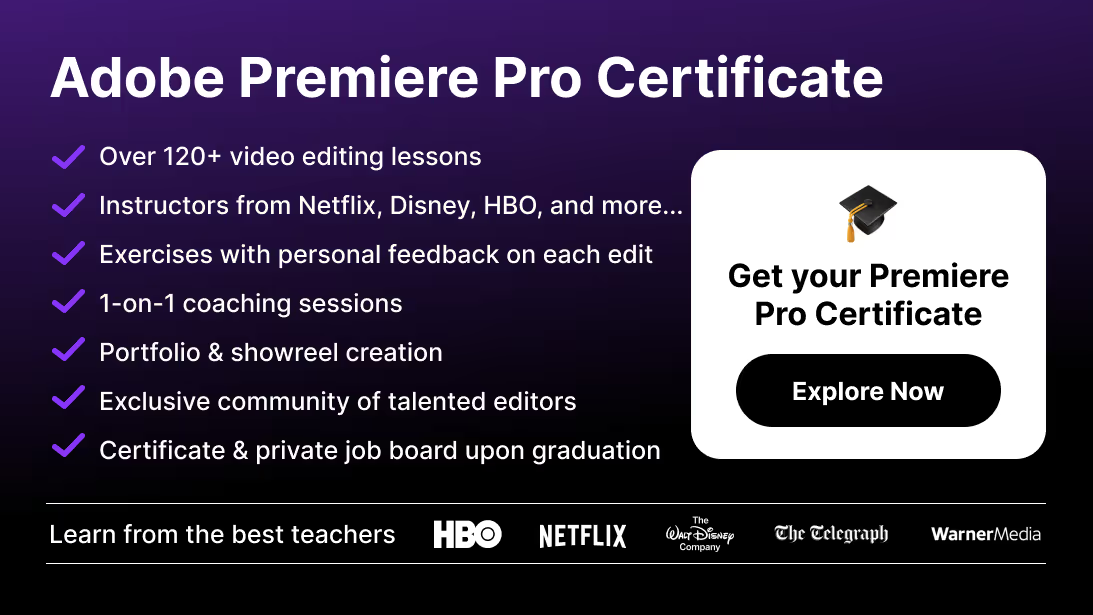Adobe Premiere Pro is one of the most widely used video editing software programs, renowned for its professional-grade capabilities. If you’re just starting out, you might wonder, “How difficult is it to learn Premiere Pro?” In this article, we’ll break down the learning curve and offer actionable tips to help you get started.
If you want a complete step-by-step breakdown of the best free methods, here’s our full guide on how to learn Premiere Pro for free to get started with zero budget.
What Can You Do with Premiere Pro?
Premiere Pro is versatile enough to handle projects ranging from casual video edits to full-scale productions.
Popular Use Cases:
- YouTube Content Creation: Edit and polish vlogs, tutorials, and reaction videos with ease.
- Short Films and Documentaries: Many independent filmmakers rely on Premiere Pro for its robust editing capabilities.
- Corporate and Marketing Videos: Create professional training, promotional, and advertisement videos.
- Social Media Content: Easily crop, resize, and edit videos for Instagram, TikTok, and other platforms.
How Difficult is it to Learn Premiere Pro?
The challenge of learning Premiere Pro depends on your prior experience with video editing, your willingness to learn, and the resources you use.
Biggest Hurdles for Beginners:
- Complex Interface: The abundance of tools and panels can feel overwhelming initially.
- Understanding File Management: Learning to organize your footage and projects properly is crucial.
- Mastering Export Settings: Knowing how to render and export videos for various platforms takes practice.
Why It Gets Easier Over Time:
- Familiarity with the timeline and basic tools allows for quick edits after just a few sessions.
- Shortcuts and workflows become second nature with consistent use.
Learning Premiere Pro vs. Other Applications
Easier or Harder?
- Compared to After Effects: Premiere Pro is much easier since it focuses on editing, while After Effects is geared toward creating motion graphics and visual effects.
- Compared to iMovie: Premiere Pro is more complex but offers significantly greater creative control and flexibility.
- Compared to DaVinci Resolve: Premiere Pro is easier to start with, but Resolve may be better for advanced color grading and finishing.
If you're still exploring structured options beyond free learning, you can also look into local or online video editing courses near you to find the best format for your goals.d
Strategies for Learning Premiere Pro
- Start with Free Tutorials: Adobe offers beginner-friendly guides, and YouTube has countless walkthroughs.
- Follow Structured Courses: Enroll in an online course that covers everything from basic edits to advanced techniques.
- Practice Daily: Dedicate time to small projects like cutting together family videos or creating montages.
- Experiment with Features: Try tools like Lumetri Color, keyframing, and multi-camera editing to expand your skillset.
- Replicate Pro Workflows: Watch professional editors and try to replicate their process.
To speed up your learning and editing efficiency, make sure your interface is well-organized — here’s the guide to the best Premiere Pro workspace layout to edit faster and avoid confusion as a beginner.
Unlock Premiere Pro’s Potential with Advanced Skills
To elevate your work to a professional level, focus on these advanced techniques:
- Motion Graphics and Titles: Integrate text and animations for polished videos.
- Color Grading: Use Lumetri Scopes to match colors and achieve cinematic looks.
- Audio Enhancements: Synchronize, clean, and layer audio tracks for seamless sound.
- Dynamic Link with After Effects: Create advanced effects and transitions without leaving the Adobe ecosystem.
Quick Wins for Beginners
- Edit a Simple Project: Start with a short video to familiarize yourself with the interface.
- Use Presets: Premiere Pro comes with built-in transitions, effects, and export presets that make your first projects easier.
- Explore Workspaces: Learn to switch and customize workspaces for editing, color, and audio.
How Difficult is it to Learn Premiere Pro?
The difficulty of learning Premiere Pro depends on several factors, including your prior experience with video editing, your technical skills, and your willingness to practice.
Beginner Level:
For someone completely new to video editing, Premiere Pro can feel overwhelming. The interface is packed with tools, panels, and options that might appear daunting at first. However, Adobe provides a variety of tutorials to help beginners get started.
Intermediate Level:
If you have some experience with other video editing software, learning Premiere Pro becomes significantly easier. Many tools and workflows are intuitive and similar to other industry-standard programs.
Advanced Level:
Mastering advanced features like multi-camera editing, color grading, and motion graphics can take time. However, with consistent practice and training, you can unlock Premiere Pro’s full potential.
How Does Learning Premiere Pro Compare to Other Applications?
Learning Premiere Pro can be challenging, but how does it stack up against other creative applications or fields?
Compared to Other Video Editing Software:
- Easier than After Effects: Premiere Pro focuses primarily on video editing, while After Effects specializes in motion graphics and visual effects.
- More complex than iMovie: While iMovie is user-friendly, it lacks the depth and capabilities of Premiere Pro.
Learn Premiere Pro with Hands-on Training at Miracamp
For those looking for structured, hands-on training, consider Miracamp’s comprehensive Adobe Premiere Pro Course,
If you're wondering what real career outcomes look like, here’s whether you can actually land a job after completing a video editing bootcamp.
Why Choose Miracamp?
- Expert instructors: Learn from professionals who’ve worked with leading companies like HBO.
- Hands-on projects: Practice with real-world examples.
- Career support: Get help building a demo reel and finding freelance opportunities.
To strengthen your credibility even more as you learn, you can also a Premiere Pro certification that helps you stand out to clients and employers.
FAQ Learning Premiere Pro
1. Is Adobe Premiere Pro hard to learn?
Premiere Pro can feel overwhelming for beginners due to its complex interface and range of tools. However, with practice and the right tutorials, most people can learn the basics within a few weeks.
2. How long does it take to learn Premiere Pro?
It typically takes a few weeks to become comfortable with basic features like cutting, trimming, and adding transitions. Mastering advanced techniques like color grading and motion graphics can take several months of consistent practice.
3. Can beginners learn Premiere Pro?
Yes! Premiere Pro is beginner-friendly when approached with patience. Adobe provides tutorials, and there are countless free resources online to help new users.
4. Do I need any prior experience to learn Premiere Pro?
No prior experience is necessary. Beginners can start with basic editing techniques and gradually explore advanced tools as they gain confidence.
5. What are the hardest features to learn in Premiere Pro?
Advanced features like Lumetri Color for color grading, multi-camera editing, and motion graphics integration with After Effects are some of the most challenging aspects for new users.
6. What’s the best way to learn Premiere Pro?
The best approach is to combine structured courses, hands-on practice, and project-based learning. Start with Adobe’s official tutorials or free resources on YouTube, then take on small editing projects to apply your knowledge.
7. Is Premiere Pro harder to learn than other video editing software?
Premiere Pro is more complex than beginner tools like iMovie but easier to learn than After Effects. Its balance of power and usability makes it a great choice for aspiring video editors.
8. Can I learn Premiere Pro for free?
Yes, Adobe offers free beginner tutorials, and there are many YouTube videos and online guides available at no cost. However, paid courses often provide more structure and depth.
9. What equipment do I need to learn Premiere Pro?
You’ll need a computer capable of running Adobe Premiere Pro smoothly. A good pair of headphones, a mouse with a scroll wheel, and plenty of storage space for video files are also recommended.
10. How can I make learning Premiere Pro easier?
Start with small projects, explore pre-built templates, and use keyboard shortcuts to speed up your workflow. Consistent practice and experimenting with features will also help you learn faster.






